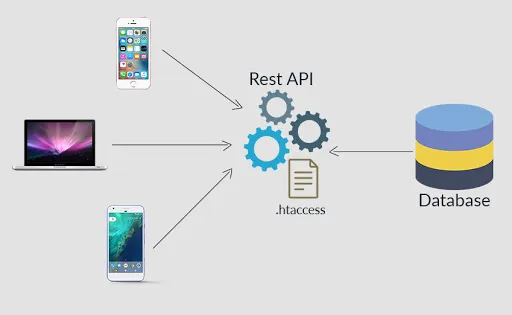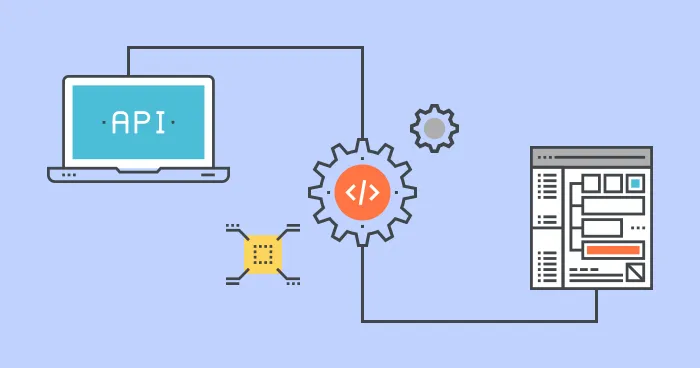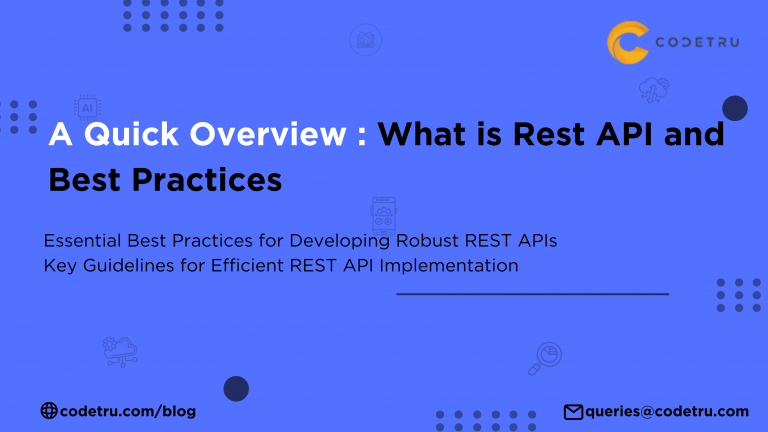A Quick Overview of What is Rest API and Best Practices
Introduction to Rest
Acronym Rest means Representational State Transfer. If you are a professional working in or around web service technology you would have heard of Rest and its various applications. Rest APIs allow clients such as browser apps to communicate with the servers. Rest gives flexibility because it is not tied into any methods or resources and it is equipped to handle different data formats and calls. Within the software development environment, one of the critical requirements has been the need for shared data within the multiple systems.
Rest API Example
You want to buy life insurance. When you check online with the insurer, the insurer will have to get your personal stored information from different agencies. The insurer will check your health condition, credit score, employment, and other such details. All of this data transfer will take place real-time between different servers so that the insurer can decide whether or not you qualify for a policy.
Contents
- What is Rest
- What is API
- Best Practices in Rest API
What is a Rest API?
In Rest API, the HTTP requests are sent to modify data within the Rest standards. This helps two or even more software to communicate with each other. Specific methods are used similar to making remote calls in order to work with data in the required format. Every app is different and there could be different applications, language, database, operating system, and so on, in order to interact with each other. When it comes to communicating with other applications and bridging the gap between them, Rest API offers the first choice. When using the Rest API, here are some of the ideas that are kept in mind.

- Rest is based entirely on HTTP
- There are no limitations or restrictions in the formats used in data exchange
- Rest API focuses on the resources and the operations performed using HTTP
- It offers flexibility and you can easily modify the APIs so that you can easily understand the format of data received or responded.
It was the year 2000 when Roy Fielding, a computer scientist, defined Rest principles in his PhD thesis. In the last 20 years, there have been several new additions and enhancements to Rest and this has helped enhance the software development.
Best Practices in Rest API
Keeping the future in mind is crucial when using Rest API in software development. This will help the client in handling issues that may arise in the long run. Here are some of the best practices that can be implemented in your development environment.
Communication Using JSON
JSON (JavaScript Object Notation) is standard when it comes to transferring data. The Rest APIs should accept JSON to send responses and accept payload. With Rest it is possible to use different output formats such as CSV, RSS, XML, Plain text, JSON, and so on. The output may largely depend on the kind of application that you have and specifically what are you looking to use your API for. If you are planning to have a service that is public facing and want to use Rest API then you definitely need to use JSON. The best thing is that JSON is a generic MIME, and so it makes it a practical approach.
Use of Nouns
In the application you will be working with resources. It is the HTTP methods that define actions on the resources such as POST, GET, PUT, DELETE, PATCH. When working on the API development Rest approach, you need to make sure to only use nouns and not verbs in the endpoint paths. This request method in HTTP has a verb. This standard practice in React API helps with efficient functioning of the program.
Resource Nesting
When showing hierarchy or relations you need to use resource nesting. Oftentimes, the resource objects have some type of intercalation or hierarchy with each other. Think about this as an example of a shop. There is often a ‘user’ and there is ‘order’, the order belongs to a user and that is a kind of interrelation between them. Usually, when working in the Rest API, it is a good idea to limit resting to just one level. It may not give a good aesthetic appeal if there are too many nesting levels.
Handling Error
When someone sends a request to your API, the last thing they want to see is an error. However, if the user sees an error in response then it is best that you explain to them what the error is, why it occurred and how to handle it. One of the best practices when working in the API environment is to handle errors efficiently. It is also crucial to have an efficient API testing setup because if an error is identified earlier, it helps to handle it without spending a lot of time and money. It is crucial to implement handling the standard HTTP error code. There is no need to reinvent the wheel as there are many other codes available, and so it makes it easy to pick up some from the available resources and use it.
Implement Versioning
Implementing versioning is best practice to follow in your Rest API. So when you have to make changes to the data structure, the overall process will be much easier. Even if there are non backward compatible changes or if these are breaking, the versioning will still prove to be of great help. With time you may need to manage multiple Rest API environments, and versioning will help you in the modification and implementing any changes in the future. Generally, there are two ways to effectively implement versioning. You can either implement it in the endpoint URI or can do it in the request header. Endpoint URI is used more often in the industry as it also helps in discoverability and the readability.
Documentation API
Documentation is a crucial aspect that you can’t afford to miss out on. This not only helps the users to understand what they can get from the API, but the developers are also aware of what to expect with integration. It is best to have the API documentation published in a web page that can be easily browsed. When the API documentation is well written and helps the developers and users, it gives a good impression about the company.
The above mentioned best practices are just a few of the many that need to be implemented for an efficient Rest API environment.
Experienced Rest API Developers

Rest API is a norm in web development technology. If you are looking for an experienced web development company to work with the Rest API for one of your projects, our team at Codetru will be happy to help. We have a dynamic team working with this and many other modern software development tools. Our team carefully identifies your business needs and crafts a customized solution to drive software development for your company.
Let us get in touch and discuss ways in which Rest API can help in your upcoming project.
FAQs About REST API Best Practices
1. What is REST API?
The REST API (Representational State Transfer Application Programming Interface) enables software applications to communicate with each other over the Internet. It uses standard HTTP methods (GET, POST, PUT, DELETE) to manipulate data and supports multiple data formats, making it a versatile option for web development
2. Why should I use JSON in my REST API?
Using JSON in a REST API is recommended because JSON (JavaScript Object Notation) is a small data exchange format that is easily read and written by humans and machines. It is also a common MIME type, making it suitable for large numbers of applications is the same, and is widely accepted as the standard for API communication.
3. What are the benefits of using nouns in REST API endpoints?
Using nouns in REST API endpoints ensures that the API is resource-focused, which aligns with REST principles. This practice helps define clear and consistent endpoints, such as /users or /orders, and allows HTTP methods (like GET, POST, PUT, DELETE) to specify actions, improving the clarity and efficiency of the API design.
4. How can I handle errors effectively in REST API?
Effective error handling in a REST API requires clear and informative error messages describing what went wrong and how to fix it. Using standard HTTP error codes and having a robust API testing process ensures a smooth experience for API customers, and can help identify and resolve issues quickly.
5. Why is versioning important in REST API development?
Versioning is important in REST API development because it makes backward compatible changes easier to modify. By modifying your API (e.g., /v1/users), you can introduce new features or changes without disrupting existing clients, ensuring a stable and manageable API lifecycle.







